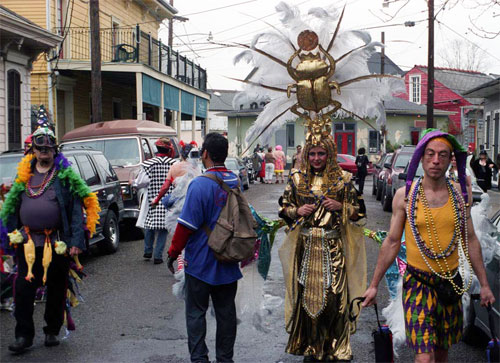THE PARADES go on for weeks, beginning January 5th and intensifying during the 10 days before Fat Tuesday. The parades are about two things: school marching bands, and throwing and grabbing beads, tons and tons of beads. Meanwhile - a new wrinkle - helicopter surveillance goes on overhead, nonstop.






THE MOST POPULAR of the krewes, or parading organizations, is Zulu, which began in 1909 as an African American krewe, and still has a largely African American membership. (For a discussion of the social structures of the krewes, see the Interview with Joseph Roach)


THE MARDI GRAS INDIANS
BY FAR THE MOST THRILLING, AND UNDERGROUND, PART OF MARDI GRAS are the forays by the Mardi Gras Indians. They go out unannounced ("We're comin' out Mardi Gras mornin' / Ain't givin' no kind of warnin'") on Mardi Gras day. If one tribe encounters another, there is an elaborate protocol. I heard about several encounters that took place on Mardi Gras 2005, but I witnessed one.
I was at the Backstreet Cultural Museum, where Big Chief Alfred Doucette was with the Flaming Arrows tribe. Also there were members of the Northside Skull and Bones Gang, who go out at 6:00 AM to wake up the neighborhood. They wear skeleton suits (pretty clearly a descendant of the Haitian Guede) with papier-mache heads and carry bloody joints of meat. Also there were the Baby Dolls, a troupe of adult women (the oldest is 82) who dress as belle-epoque babies, with satin bonnets, pacifiers, and bottles (which might contain vodka). The Skeleton on the left in this photo is Bruce Barnes, better known as Sunpie, a ferocious zydeco accordionist.

Here's Big Chief Doucette with Antoinette K-Doe, leader of the Baby Dolls and proprietor of the famed Mother-in-Law Lounge.

Here's Baby Doll Helen Regis.

Then I heard drums. Down the street came Congo Nation, led by Big Chief Donald Harrison, Jr.


The two chiefs met and greeted one another.

MEANWHILE, OVER ON FRENCHMEN STREET . . .
ON MARDI GRAS DAY, EVERYONE MASQUERADES.
The area around Frenchmen Street, just below the French Quarter, is known for its lively, occasionally risqué, carnival.








If you're visiting New Orleans, don't miss the Backstreet Cultural Museum, 1116 St. Claude, in the Tremé.
Books worth checking out:
Florence, Robert and Mason Florence. (1997). New Orleans Cemeteries. Batture Press, New Orleans.
John, Dr. (1994). Under a Hoodoo Moon: The Life of Dr. John the Night Tripper. St. Martin's Press, New York.
Ritz, David. (2000). The Brothers Neville. Little, Brown, Boston.
Roach, Joseph. (1996). Cities of the Dead: Circum-Atlantic Performance. Columbia University Press, New York.
Smith, Michael P. (1994). Mardi Gras Indians. Pelican Publishing Company, Gretna, LA.
CDs for suggested listening
*= contains tunes featured in the show
New Orleans is a riot of musicians and small labels. The best way to find anything made in New Orleans is to check with the Louisiana Music Factory, a record store specializing in local music (though they don't handle hiphop).
Mardi Gras Indians:
*Donald Harrison: Big Chief Donald Harrison, Jr. presents The New Sounds of Mardi Gras II (FOMP)
*Cyril Neville and the Uptown All-Stars: For the Funk of It (no label name)
The Wild Magnolias: The Wild Magnolias (Polydor)
*The Wild Tchoupitoulas: The Wild Tchoupitoulas ( Island)
Bands:
*James and Troy Andrews: 12 & Shorty (Keep Swingin')
Bonerama: Live From New York(Bonerama)
Jon Cleary and the Absolute Monster Gentlemen: Pin Your Spin ( Basin Street)
Dr. John: N'Awlinz, Dis Dat or D'udda (Blue Note)
Los Hombres Calientes: Vol. 5: Carnival ( Basin Street)
Hot 8 Brass Band: Rock with the Hot 8 ( Louisiana Red Hot)
Kirk Joseph: Kirk Joseph's Backyard Groove (no label name)
The Neville Brothers: Walkin' in the Shadow of Life (Neville Nation / Virgin / EMI)
*Kermit Ruffins and Rebirth Brass Band: Throwback ( Basin Street)
The Soul Rebels: Rebelution (Barn Burner)
Sunpie and the Louisiana Sunspots: Zydeco's Got Soul (BFR)
Anthologies:
Mardi Gras Essentials (Hip-O)
* New Orleans Party Classics and More New Orleans Party Classics (Rhino). More includes Bo Dollis's "New Suit".
Hiphop (explicit lyric advisory):
B.G.: Life After Cash Money (Chopper City / Koch)
Da Blockburnaz: Overheated (Big Boy)
Mannie Fresh: The Mind of Mannie Fresh (Cash Money / Universal)
*Juvenile: Juve the Great (Cash Money / Universal)
*Lil Wayne: The Carter (Cash Money / Universal)
The Greatest Rap Hits from Downsouth New Orleans(TTH)
Celebrating 15 years of association with Afropop Worldwide, Ned Sublette, author of Cuba and Its Music: from the First Drums to the Mambo, is a 2004-2005 Tulane Rockefeller Humanities Fellow at the Stone Center for Latin American Studies and the Deep South Humanities Center.









